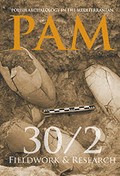Problems and solutions in dating Nabataean pottery of the post-annexation period
Problems and solutions in dating Nabataean pottery of the post-annexation period
Author(s): Tali Erickson-GiniSubject(s): Archaeology, Cultural history, Visual Arts, Regional Geography, Local History / Microhistory, History of Art
Published by: Wydawnictwa Uniwersytetu Warszawskiego
Keywords: pottery; Nabataean period; post-annexation period;
Summary/Abstract: In the desert regions of the Southern Levant, the dating of Nabataean sherds and vessels is a critical factor in determining the dates of archaeological strata, architecture, and even entire sites. In recent years, archaeologists working at Petra and related sites have tended to date most Nabataean sherds and vessels to the 1st century CE based on the proposed typo-chronology of the Swiss–Liechtenstein excavations at ez-Zantur in Petra, published by Stephan G. Schmid (2000). Accepted typo-chronologies must withstand scrutiny and can override imposed historical frameworks. However, an uncritical reliance on the ez-Zantur chronology has created an artificial gap in the material record of Petra and other Nabataean sites in the post-annexation period, that is to say, the 2nd and 3rd century CE. This paper provides a critique of the Nabataean fine-ware typo-chronology from ez-Zantur, based on finds from other excavations and sites, and proposes a revised chronology in which the production of Nabataean pottery, including painted and unpainted fine wares, unguentaria and lamps, continues unabated throughout the Middle Roman period until sometime in the first half of the 3rd century CE. The revised typo-chronology evinces a robust period of Nabataean culture at Petra and other related sites under Roman rule, like that found in other cities of the Roman East.
Journal: Polish Archaeology in the Mediterranean
- Issue Year: 2/2021
- Issue No: XXX
- Page Range: 681-706
- Page Count: 26
- Language: English

